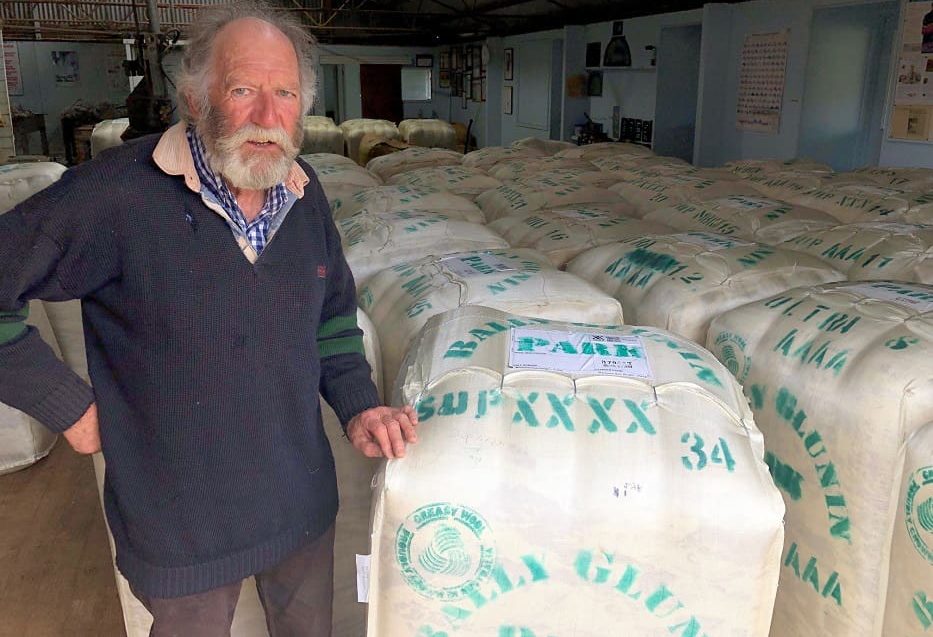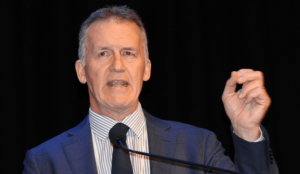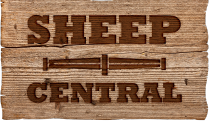
Michael Blake with the 2024 Bally Glunin Park Clip.
FOR the first time in 40 years, Hamilton district wool growers Michael and Cathy Blake will sell their Merino clip without a wool quality assurance brand.
They have been with SustainaWOOL since 2015, and their Bally Glunin Park was the first property to sell under the now defunct premium non-mulesed SustainaWOOL Gold standard.
However, this year due to issues Mr Blake discovered with the integrity scheme’s documentation after his annual audit in October 2023, the classed superfine clip will be sold next week with only the EU Ecolabel accreditation.
This was before the SustainaWOOL Integrity Scheme was morphed into the Australian Wool Sustainability Scheme by the Australian Wool Exchange
In July this year, AWEX launched its new version the AWSS with a non-mulesed wool stream – to be branded SustainaWOOL – and the breech modification with pain relief stream – ResponsiWOOL.
The Bally Glunin Park Merino flock has been non-mulesed since 2007 under a quality assurance program developed by Mr Blake, who shared it with AWEX and incorporated into the National Wool Declaration.
“I’ve been involved with SustainaWOOL since its conception in 2014 and watched it and nurtured it,” Mr Blake said.
The SustainaWOOL™ Integrity Scheme was launched in 2015 by New England Wool Pty Ltd and Italian fabric makers Successori Reda and Vitale Barberis Canonico in response to demand from consumers and retailers. In 2019, the ownership of SustainaWOOL was transferred to AWEX. In 2019, more than 950 farms had been accredited, making it the largest sustainability scheme in the wool industry worldwide at the time.
Mr Blake periodically worked with NEW managing director Andrew Blanch on SustainaWOOL developments prior to development of the AWSS, including adding pain relief, auditing and occupational health and safety components.
The Victorian wool grower is recognised in Australia and overseas as a pioneer and valued consultant on issues of farm safety, biosecurity and environmental management of land, with in-depth experience in wool quality assurance schemes. He was involved with the early development of CattleCare, Flockcare, the GO MARK Company and Safety MAP, in the late 1990s. In 2019, Mr Blake’s work in these areas was recognised with an Australian Wool Industry Medal.
Inconsistencies found in auditing documents
BallyGlunin Park has also sold wool through the Merino Company’s EU Ecolabel standard, but Mr Blake said he has been committed to the SustainaWOOL standard as being more applicable to Australian conditions.
However, in November 2023 after being audited by an AWEX auditor for SustainaWOOL GOLD, Mr Blake raised issues with AWEX CEO Mark Graves about discrepancies in the auditing paperwork (version 8).
“I’m more concerned about this scheme because it’s an Australian scheme, it’s backing itself with its integrity, but the integrity of it, from my point of view is not there,” Mr Blake said.
Mr Blake said at the 2023 audit there was a lack of synchronisation between components in the auditor’s book and his grower’s book. The numbering of audit components and some of the titles between the two books were not consistent in 86 cases, Mr Blake said.
For example, section 1.16 in the grower’s book related to whether staff were provided adequate instruction and training for stock handling, whereas in the auditor’s book section 1.16 asked whether all the wool in the clip come from sheep bred on the property.
“They didn’t match.”
Mr Blake said Bally Glunin Park has operated under 16 different quality assurance schemes since 1997.
“And in that period of time we have been audited 96 times, either physical, random, desk top or satellite audits, so I think I understand auditing.”
Mr Blake said some of the 86 mismatched SustainaWOOL audit components required urgent change if they had not been dealt with by the grower. This mean the inconsistencies could jeopardise the quality assurance integrity of the property, he said.
In January this year, Mr Blake detailed to AWEX all the inconsistencies and offered a method of changing the paperwork, but this was not accepted or acted on, he said.
“The problem for me is that the foundation of inaccuracy has not been changed.”
SustainaWOOL drafts exchanged
Mr Blake said a draft version of SustainaWOOL documentation was exchanged (version 8.1) with Mr Grave. But the grower said AWEX has never acknowledged the inconsistencies nor publicly declared that they have been corrected, although some mills in Italy and France, and a few people in Australia were aware of the issue.
“It was never done … and because they’ve never done that in reality the integrity of that scheme was not there.
“So for me that’s the big issue, because I can’t sign a declaration in the future knowing that the foundation was wrong,” Mr Blake said.
“You’ve got to take into account when they knew in November (2023) that there were errors and they continued to audit people afterward, then their audit sign-offs were actually false declarations.”
Mr Blake said an expert panel appointed to provide guidance on standards and evidence for the new AWSS scheme should have been informed and investigated the foundation scheme’s auditing inconsistencies.
Reading from the version 8.1 from Mr Grave, Mr Blake said section 5.12 in the auditor’s book asked whether the shearing shed environment is safe and healthy with adequate amenities and well-maintained shearing machinery, whereas 5.12 did not exist in the grower’s book. The shed and machinery aspect is listed under another number in the grower’s book — 4.12.
“It’s not there … now if you’re an auditor and you write your corrective action on it, then you use a number, but the numbers don’t relate.
“That was how this all come about that they don’t relate … it all comes apart at 1.16, from then it’s all wrong.”
Mr Blake said only a WorkSafe inspector had the authority to do workplace inspections.
In a physical audit, after checking off each item in their book an auditor downloads the grower’s completed book and then compares their inspection impressions with the grower’s statements. Mr Blake said the operation passed his last SustainaWOOL GOLD audit in October 2023, by providing information to the auditor that related to each component, but using the inconsistent format.
“When we got to the end of the 2023 audit I said to the auditor there appears to be some inconsistencies in the two documents and he said ‘yes’, after the audit.
“He was going to Sydney the next day because all of the auditors were going to be there and he said this is going to be an interesting discussion,” Mr Blake said.
“On Melbourne Cup day I sent an email to Mark Grave for them for discussion for this, to fix this – that was the next day.”
On November 14, after finishing his SustainaWOOl GOLD audit crosscheck with the auditor’s document Mr Blake emailed Mark Grave to tell him there were significant differences between the auditors V8.0 and the growers V8.0 from 1.16, in the (sections) 4’s, 5’s, 6’s and 7’s. He told Mr Grave the auditor and grower books need to be aligned to have integrity. Mr Grave acknowledged that Mr Blake’s feedback was valuable “as we have the inspectors together this week for a calibration work shop.”
However, in January 2024 when Mr Blake detailed to Mr Grave all the inconsistencies, outlined how they could be overcome and pointed out that AWEX needed to acknowledge the issues, the AWEX CEO said SustainaWOOL had just passed its audit by global auditors JAS-ANZ under ISO 9001.
Mr Blake said he texted back: “Yes, they weren’t looking where I was.”
Mr Blake told Sheep Central that the AWSS has to be “squeaky clean” to counter criticism from competing schemes.
“My passion in all of this has been to be able to say that whatever we do, its integrity is intact, and unfortunately this is not the case.
“It would be very easy for me to shut my mouth and get on with it,” he said.
Mr Blake maintains that he had not been notified that corrections were made nor has AWEX publicly acknowledged this. The SustainaWOOL version 8.1 was never made public.
“They haven’t put it in the public domain.”
Mr Blake believes SustainaWOOL audits would have been done while the document discrepancies existed.
“I see this as a chink in their armour and this system of all of the global quality assurances is still the best for Australian wool delivery to the world.
“If it’s grey area then, it’s a grey area from then on.”
Mr Blake said his concern about the AWSS’s integrity had to be seen in the context of the proposed International Wool Textile Organisation’s ‘Green Book’ as a global reference point to define traceability and sustainability standards for wool.
“I wanted this scheme to be perfect so it would sail into the Green Book and be number one, now I don’t know.”
Mr Blake was also concerned about the AWSS ResponsiWOOL stream for wool produced from sheep mulesed with appropriate pain relief.
“The problem is that RWS (Responsible Wool Standard) is patented as a trademark and it’s non-mulesed and here we have RW, which allows for mulesing.”
Discrepancies did not impact integrity – AWEX

AWEX CEO Mark Grave
Sheep Central asked Mr Grave whether the inconsistencies highlighted by Mr Blake were important enough to require correction and if they compromised the integrity of SustainaWOOL audits. Mr Grave was also asked if any audits were conducted while these numbering inconsistencies existed between the auditor and grower books and whether they were subsequently corrected in the auditor and grower books for the AWSS.
Mr Grave told Sheep Central that the former SustainaWOOL Integrity Scheme was retired at the end of June 2024 and replaced by the AWSS, which was announced in April this year and launched on July 18, 2024.
“This change was a result of consultation with domestic and international stakeholders to determine the optimal structure of an Australian wool sustainability scheme.
“Industry feedback indicated that the previous three-tier system under SWIS, was confusing and too complex for the market,” he said.
“The decision to simplify the AWSS offering was necessary and communicated to all SWIS members, Mr Grave said.
“The questions raised in your (Sheep Central’s) email were regarding formatting discrepancies between the SWIS checklist used to assist growers to prepare for an on-farm audit and the SWIS checklist provided to auditors during on-farm audits under the previous SWIS Grower Standard.
“The Grower Standard is the key document,” Mr Grave said.
“Any discrepancies between the checklists did not impact the requirements of the audit.
“Importantly, they did not affect growers’ ability to meet the Standard, nor did they compromise the integrity or outcome of the audits themselves,” he said.
“When these concerns were raised with AWEX, the closing stages of the retirement of the SWIS and the transition to the AWSS were being finalised.
“This was communicated at the time,” Mr Grave said.
“Post-launch, to address the specific concerns, a copy of amended checklists were made for record.
“These were not published as SWIS was retired and was no longer in use, and publishing updates to obsolete documents risked market confusion,” he said.
“A record of this SWIS-related issues was logged in our Quality Management System to prevent recurrence.”
Mr Grave said under AWSS, on-farm inspections will be conducted by an independent third-party verifying body.
“A review of auxiliary materials against the AWSS Grower Standard is currently underway.”
Mr Grave said the AWSS is a response to the global market’s demand for sustainable, traceable, and high-quality wool – and responds in a way that reflects Australia’s unique production systems, stringent regulatory standards, and industry best practices.
“The scheme leverages world-class Australian wool industry tools and programs, including Australian wool classing, the National Wool Declaration, WoolClip and eBale, and is guided by advice from an independent expert panel that brings a broad expertise from organisations across Australia, and includes producers, consultants and researchers.
“AWSS marks a new era of sustainably grown, expertly prepared, and traceable Australian wool,” he said.
“This is an exciting and important step for Australian wool.”

HAVE YOUR SAY